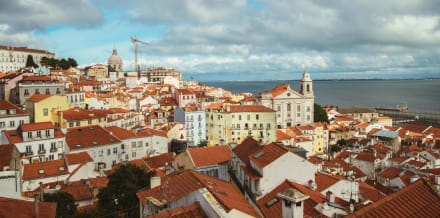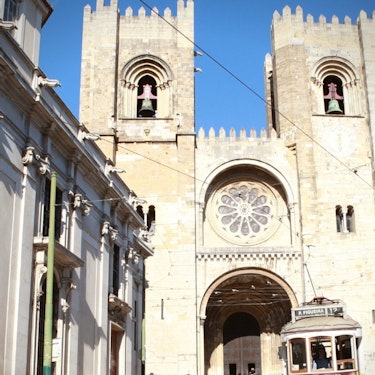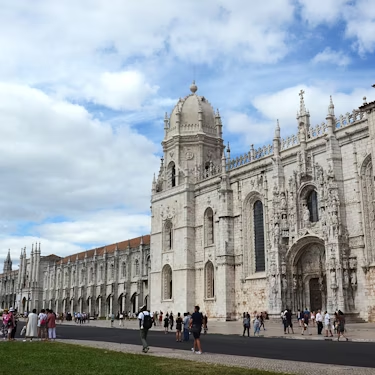More about: 10 Things to Do in the Lisbon City Center
The capital of Portugal is a destination that will make you fall in love. The neighborhoods of the historic center captivate travelers with their bohemian atmosphere, tile-covered facades, and steep hills leading to viewpoints. You won't want to go home.
1. Discover Lisbon with a guided tour

If you're short on time, a guided tour of Lisbon is the perfect option. In two hours or so, you'll discover the essentials of Lisbon. The guides know every inch of the city and enliven the tour with unique and entertaining anecdotes.
City tours usually start at Praça do Rossio or other central areas such as Praça do Comércio or Largo do Chafariz de Dentro, where the Fado Museum is located.
The city center tour explores the most important tourist attractions such as the neo-Manueline Rossio station, the Igreja de São Domingos, the Santa Justa elevator, the viewpoints, and the Carmo Convent.
2. Relive the history of Lisbon in its Cathedral

On October 25, 1147, Christian troops led by Afonso Henriques (the first king of Portugal) entered Lisbon after defeating the Muslim army. After four centuries, the Moors lost control of al-ʾIšbūnah, an important commercial center on the Tagus estuary. To celebrate this event, the monarch ordered a cathedral to be built on the ruins of the old mosque.
The person in charge of the task was Gilbert of Hastings, an English monk who participated in the siege and was appointed bishop at the end of the conflict.
Like other buildings in the Portuguese capital, the cathedral also suffered severe damage from earthquakes. The 1755 earthquake, for example, completely destroyed the Gothic chapel and the royal pantheon. As you cross the threshold, you will see simple interiors where darkness reigns. At the top, you can visit the treasure: four rooms with costumes, relics, and jewels that belonged to illustrious figures.
3. Climb up to St. George's Castle
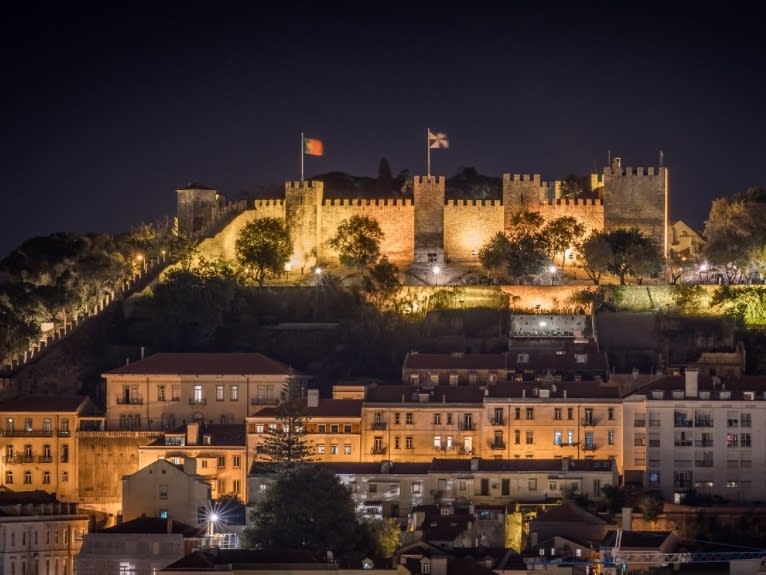
This monument has always watched over Lisbon. According to historians, the castle was built by the Visigoths and expanded during the Muslim period. When it was conquered by the troops of Afonso Henriques (the future first king of Portugal), Islamic elements gave way to Christian ones.
Over the centuries, the fortress has witnessed numerous historical events and has served as both a royal palace and a military fortification. Today, many tourists climb to the top of the hill to stroll along its walls and enjoy the unbeatable view of the city and the Tagus River. If you would like to enjoy the experience, I recommend booking a guided tour of São Jorge.
4. End the day at a traditional restaurant

One of Lisbon's attractions is its rich cuisine. The Portuguese capital has many establishments offering traditional dishes without breaking the bank. Below is a list of some of the most famous places to eat:
- O Pitéu: a great place to try the country's most representative dishes. I recommend trying the Mozambique prawns or the bife da vazia de novilho (Largo da Graça 95-96).
- Floresta das Escadinhas: an authentic restaurant in the heart of the tourist area. Its specialty is grilled fish, and you can't leave without trying the sardines or roasted octopus. The restaurant also stands out for its service (Rua de Santa Justa 3).
- Frangasqueira Nacional: the temple of chicken. Near the Jardim do Príncipe Real is a traditional establishment that is a real institution among locals and tourists alike. According to those in the know, it is one of the top five chicken restaurants in central Lisbon (Tv. Monte do Carmo 19).
- Chapitô à Mesa: a unique place that is well worth a visit. The restaurant is attached to a circus school and is located a stone's throw from the castle. In addition to its quality Portuguese dishes, many customers choose it for dinner with a splendid view of the city (Costa do Castelo 7).
5. Visit Bairro Alto

Next to Chiado is Bairro Alto, a district known for its lively nightlife. At the end of the day, young and old alike flock to this area of Lisbon for a drink at Pavilhão Chinês (a bar decorated with thousands of objects from the 18th to the 20th centuries, Rua Dom Pedro V 89), Frágil (the bar that marked a turning point in the 1980s, Rua da Atalaia 128) or Noobai Café, a bar/restaurant on the Santa Catarina viewpoint.
In addition to its leisure attractions, Lisbon's Bairro Alto hides other little treasures:
- Pharmacia: an old pharmacy converted into a restaurant. Here you can eat typical dishes surrounded by dentist's chairs, stretchers, and counters. (Rua de Santa Catarina 2/4)
- São Roque Church: the temple that survived the 1755 earthquake. Its austere façade hides a richly decorated interior. (Largo Trindade Coelho)
- Praça Luís de Camões: home to the bronze statue of the poet and eight smaller sculptures representing other authors of Portuguese literature.
- Jardim do Príncipe Real: a charming romantic park frequented mainly by locals. Magnolia trees, palm trees, and a huge cedar tree guarantee tranquility and shade.
- Depósito da Patriarcal: an octagonal tank and a fundamental part of the aqueduct that supplies the city. If you want to visit it, I recommend checking the Water Museum website.
- The most famous viewpoints: São Pedro de Alcântara (Rua de São Pedro de Alcântara) and Santa Catarina (Esplanada Adamastor). The latter is very popular in the evenings.
6. Take tram 28

What would Lisbon be without its trams? Part of its charm comes from this means of transport that runs along both the avenues and the narrowest streets. This line departs from Praça Martim Moniz, a short distance from Praça do Rossio. During the journey, the 28 tram passes by the city's most famous sights:
- The Estrela Basilica
- Rua da Conceição
- The cathedral, the viewpoints
- The Church of São Vicente de Fora
The ticket costs approximately €3 and the entire journey takes between 45 and 50 minutes. However, the most picturesque part is Alfama, and if you want to stay in the center, you can get off at Largo Santa Luzia, where you will find the viewpoint of the same name. This activity is usually popular with children, and if you are interested in the subject, I recommend the post 10 things to do in Lisbon with children.
7. Wander around the area around Rossio Square
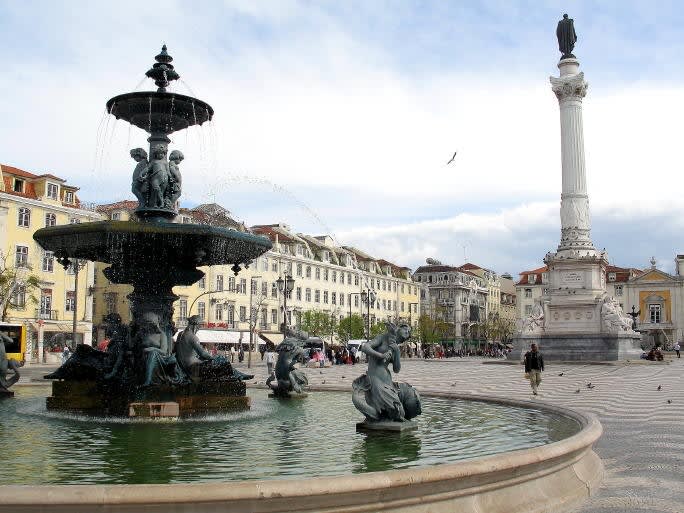
Rossio Square is the heart of Baixa and is characterized by the monument to Dom Pedro IV (the first emperor of Brazil) and its undulating black and white paving. On the north side is the National Theater, an elegant building with a neoclassical façade, a portico with columns, and a statue of Gil Vicente, the founder of Portuguese theater. A few meters from the theater, you will find another emblematic place in the Portuguese capital: the Igreja de São Domingos.
Rossio Square is also a place of passage and home to two historic establishments in the Portuguese capital:
- A Ginjinha: a tiny bar that only serves a traditional cherry liqueur called ginja.
- Café Nicola: a place with over 200 years of history. In the past, it was a bookshop and a meeting place for intellectuals. Inside, you will see a statue of the poet Bocage, who was a regular customer of the café.
8. Treat yourself to a break at Lisbon's markets

The Portuguese capital has a selection of markets offering all kinds of goods, from clothing to fresh produce. Some of these are located in the center of Lisbon and are ideal for both shopping and sampling delicacies. Read on and discover the best markets in the center:
- Mercado da Ribeira: the most sought-after destination for Lisbon foodies. Here, traditional dishes coexist with fusion cuisine, and in both cases, the quality is very high. If you're interested in good food, I recommend reading the post about Lisbon's food tours. (Avenida 24 de Julho 49)
- Feira da Ladra: a flea market with all kinds of goods, from antique trinkets to second-hand clothes. This market specializes in antiques and is the ideal place to find an original souvenir. It is held every Tuesday and Saturday in the Alfama neighborhood. (Campo de Santa Clara)
- Mercado de Santa Clara: a market that often goes unnoticed as it is located a short distance from the more famous Feira da Ladra. It was inaugurated on October 7, 1877, and its glass and steel structure was designed by architect Emiliano Augusto de Betencourt. Today, it houses craft stalls and a few bars/restaurants. (Campo de Santa Clara)
- Feira dos Alfarrabistas: an open-air market held every Saturday. It is a must-see for buying old and second-hand books. (Rua Anchieta)
9. Be captivated by the most beautiful neo-Manueline façade in Baixa

Rossio Station is one of the most emblematic monuments in Baixa. The building was constructed in the late 19th century based on a design by Luis Monteiro. The architect was inspired by the Manueline style, a purely Portuguese architectural style. Its distinctive feature is the mixture of marine elements (shells, ship ropes, corals, etc.), coats of arms, religious symbols, and Arabic ornaments.
The exterior of Rossio Station is characterized by two horseshoe-shaped entrance doors and an elegant clock tower. Another peculiarity is the platforms, which are located at a higher level than the entrance. Lisbon is a city of hills, and the architect had to adapt the tracks to the terrain.
Above the tracks, you can admire the iron roof designed by Gustave Eiffel. This railway line connects the Portuguese capital with the city of Sintra, a popular destination for day trips. In the post How to get from Lisbon to Sintra, you will find all the information you need.
10. Take a stroll through Chiado

Chiado is a beautiful shopping area that was once the heart of Portuguese Romanticism. The neighborhood is known for its quirky shops and bohemian bars, such as the famous Café A Brasileira, where Fernando Pessoa used to spend his afternoons. However, Chiado has much more to offer. Below is a list of the main points of interest:
- Santa Justa Elevator: a neo-Gothic elevator designed by engineer Raoul Mesnier du Ponsard in the early 20th century. It connects Baixa with the Chiado neighborhood.
- Luvaria Ulisses: a glove shop founded in 1925 by Joaquim Rodrigues Simões. Two large columns frame a door that opens onto a space that retains the style of the 1920s. (Rua do Carmo 87)
- Pastelaria Bénard: one of the oldest pastry shops in the Portuguese capital. I recommend trying their freshly baked croissants with raspberry jam. (Rua Garrett 104)
- A Vida Portuguesa: a charming shop that occupies the former David & David perfume factory. They sell natural soap bars, decorative items, toys, and other goods with a vintage touch. (Rua Anchieta 11)
- Convento do Carmo: the ruins of a Gothic church that belonged to the Carmelite Order. Completely devastated by the 1755 earthquake, it stands as a witness to the devastation caused by the quake. (Largo do Carmo)
- Bertrand Bookstore: The oldest bookstore in Lisbon. It has an extensive selection of works by Portuguese writers and translations into other languages, including Spanish. (Rua Garrett 73)
- Igreja do Loreto: the church of the Italians. It was built at the request of the Venetian and Genoese merchant community. (Largo do Chiado)
